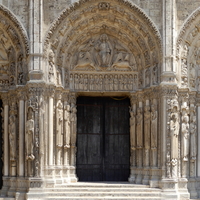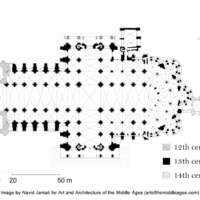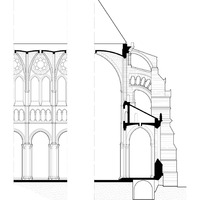Chartres Cathedral
Type:
Churches,
Portals,
Tympana,
Sculptures,
Stained-glass windows
Date:
Mid-twelfth to first quarter of the thirteenth century
Location or Findspot (Modern-Day Country):
France
Description:
Notre Dame de Chartres (or Our Lady of Chartres), a cathedral dedicated to the Virgin, is well known for its portal sculptures, stained glass, and architectural innovation. On the west facade, the three mid-twelfth-century doors feature, from left to right, tympana with (1) Christ before the incarnation, with a lintel of prophets looking upwards; (2) Christ in Majesty with the symbols of the four Evangelists, and a lintel of Apostles; and (3) scenes from the life of the Virgin, culminating with the image of the Throne of Wisdom (the Virgin enthroned with Christ on her lap). The jamb figures represent Old Testament prophets, kings, and queens.
The cathedral has a four-bay choir with double aisles and a double ambulatory. Its structure helped facilitate the movement of pilgrims, many of whom came to venerate the tunic of the Virgin, which was thought to have survived miraculously after a devastating fire in 1194 that destroyed most of the cathedral. The interior of the church, built after 1194, has a three-part elevation with a nave arcade, triforium, and tall clerestory. The pointed ribbed groin vaults, together with the flying buttresses supporting the lateral thrust, allow large stained-glass windows to illuminate the interior.
Mary as the Throne of Wisdom reappears in one of the windows that survived the 1194 fire. Several windows also include images of tradesmen or labourers. The rose window of the north transept (ca. 1235) was a gift from Blanche of Castile. In the spandrels below the rose, the heraldic castle of Castile (yellow castle on a red background) alternates with the fleur-de-lys, the insignia of Blanche's son, Louis IX.
The north and south transepts, built after 1194, also have sculpted triple doors, and their archivolts protrude outwards to create a much deeper porch—a characteristic of thirteenth-century rather than twelfth-century portals. Compared to those on the west facade, the later jamb figures are noticeably less columnar. The tympana of the north transept feature the Magi, the Coronation of the Virgin, and Job on the Dunghill. Those of the south transept (added later than the north) have much more of a focus on the lives of saints, namely Stephen, Nicholas of Bari, and Martin of Tours.
The floor of Chartres Cathedral's nave has a labyrinth that measures over 12 meters in diameter. Its circumference matches that of the rose window above it and its winding path symbolizes the route to salvation.
The cathedral has a four-bay choir with double aisles and a double ambulatory. Its structure helped facilitate the movement of pilgrims, many of whom came to venerate the tunic of the Virgin, which was thought to have survived miraculously after a devastating fire in 1194 that destroyed most of the cathedral. The interior of the church, built after 1194, has a three-part elevation with a nave arcade, triforium, and tall clerestory. The pointed ribbed groin vaults, together with the flying buttresses supporting the lateral thrust, allow large stained-glass windows to illuminate the interior.
Mary as the Throne of Wisdom reappears in one of the windows that survived the 1194 fire. Several windows also include images of tradesmen or labourers. The rose window of the north transept (ca. 1235) was a gift from Blanche of Castile. In the spandrels below the rose, the heraldic castle of Castile (yellow castle on a red background) alternates with the fleur-de-lys, the insignia of Blanche's son, Louis IX.
The north and south transepts, built after 1194, also have sculpted triple doors, and their archivolts protrude outwards to create a much deeper porch—a characteristic of thirteenth-century rather than twelfth-century portals. Compared to those on the west facade, the later jamb figures are noticeably less columnar. The tympana of the north transept feature the Magi, the Coronation of the Virgin, and Job on the Dunghill. Those of the south transept (added later than the north) have much more of a focus on the lives of saints, namely Stephen, Nicholas of Bari, and Martin of Tours.
The floor of Chartres Cathedral's nave has a labyrinth that measures over 12 meters in diameter. Its circumference matches that of the rose window above it and its winding path symbolizes the route to salvation.
Relevant Textbook Chapter(s):
7,
8,
9
Repository and Online Resources:
• See panoramas, plans, and additional images at the Mapping Gothic website.
• Watch a video on Chartres Cathedral posted at Smarthistory (with narration from Dr. Beth Harris and Dr. Steven Zucker).
• Read a debate about the cleaning/restoration of Chartres.
Image Credits:
Wikimedia Commons; Navid Jamali














